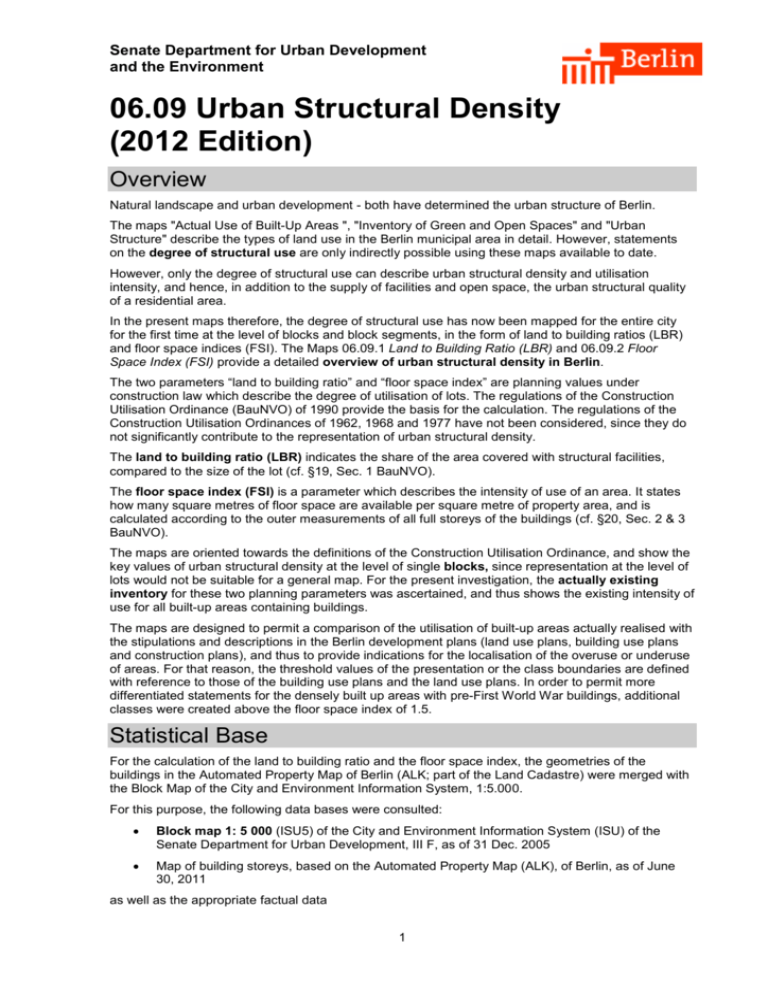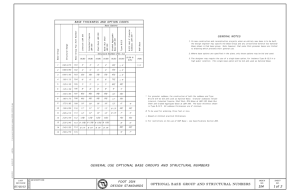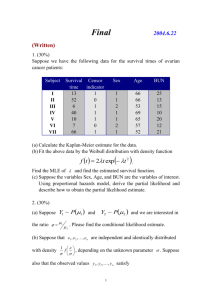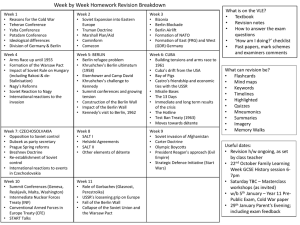06.09 Urban Structural Density (Edition 2012)
advertisement

Senate Department for Urban Development and the Environment 06.09 Urban Structural Density (2012 Edition) Overview Natural landscape and urban development - both have determined the urban structure of Berlin. The maps "Actual Use of Built-Up Areas ", "Inventory of Green and Open Spaces" and "Urban Structure" describe the types of land use in the Berlin municipal area in detail. However, statements on the degree of structural use are only indirectly possible using these maps available to date. However, only the degree of structural use can describe urban structural density and utilisation intensity, and hence, in addition to the supply of facilities and open space, the urban structural quality of a residential area. In the present maps therefore, the degree of structural use has now been mapped for the entire city for the first time at the level of blocks and block segments, in the form of land to building ratios (LBR) and floor space indices (FSI). The Maps 06.09.1 Land to Building Ratio (LBR) and 06.09.2 Floor Space Index (FSI) provide a detailed overview of urban structural density in Berlin. The two parameters “land to building ratio” and “floor space index” are planning values under construction law which describe the degree of utilisation of lots. The regulations of the Construction Utilisation Ordinance (BauNVO) of 1990 provide the basis for the calculation. The regulations of the Construction Utilisation Ordinances of 1962, 1968 and 1977 have not been considered, since they do not significantly contribute to the representation of urban structural density. The land to building ratio (LBR) indicates the share of the area covered with structural facilities, compared to the size of the lot (cf. §19, Sec. 1 BauNVO). The floor space index (FSI) is a parameter which describes the intensity of use of an area. It states how many square metres of floor space are available per square metre of property area, and is calculated according to the outer measurements of all full storeys of the buildings (cf. §20, Sec. 2 & 3 BauNVO). The maps are oriented towards the definitions of the Construction Utilisation Ordinance, and show the key values of urban structural density at the level of single blocks, since representation at the level of lots would not be suitable for a general map. For the present investigation, the actually existing inventory for these two planning parameters was ascertained, and thus shows the existing intensity of use for all built-up areas containing buildings. The maps are designed to permit a comparison of the utilisation of built-up areas actually realised with the stipulations and descriptions in the Berlin development plans (land use plans, building use plans and construction plans), and thus to provide indications for the localisation of the overuse or underuse of areas. For that reason, the threshold values of the presentation or the class boundaries are defined with reference to those of the building use plans and the land use plans. In order to permit more differentiated statements for the densely built up areas with pre-First World War buildings, additional classes were created above the floor space index of 1.5. Statistical Base For the calculation of the land to building ratio and the floor space index, the geometries of the buildings in the Automated Property Map of Berlin (ALK; part of the Land Cadastre) were merged with the Block Map of the City and Environment Information System, 1:5.000. For this purpose, the following data bases were consulted: Block map 1: 5 000 (ISU5) of the City and Environment Information System (ISU) of the Senate Department for Urban Development, III F, as of 31 Dec. 2005 Map of building storeys, based on the Automated Property Map (ALK), of Berlin, as of June 30, 2011 as well as the appropriate factual data 1 number of storeys of buildings building type land use of blocks/ block segments urban structural type/area type of blocks/ block segments. With the aid of these data bases, the land to building ratio (LBR) and the floor space index (FSI) were ascertained for a total of 24,669 blocks and block segments. Methodology Ascertainment of the Number of Storeys in Buildings The ascertainment of the number of storeys in the buildings was carried out by entering the number of storeys in the Automated Property Map of Berlin (ALK). For buildings for which the number of storeys has not been entered, an estimated value was used to calculate the floor space index: 2 for ruins, and 8 for towers. Ascertainment of the Land to Building Ratio The land to building ratio (LBR) states the built-up proportion of a lot. The LBR is a decimal number with one or two fractional digits. Thus, the formula for the calculation of the LBR for the preparation of the present map is derived as follows: The sum of all built-up areas on a lot - here, the block area - is divided by the total area. Since in rare cases the areas of buildings do not agree with the block area boundaries, only the shares of those built-up areas have in those cases been compiled which were actually within the block area boundaries. This was accomplished by overlaying the building boundaries (ISU5) from the Automated Property Map (ALK) onto the block areas of the Block Map, 1:5,000. The building parts outside the block areas, e.g. on traffic areas (street land), were then not taken into account. Ascertainment of the Floor Space Index The floor space index (FSI) states the number of square metres of floor area per square metre of lot area, compiled at the level of the total block area. For the ascertainment of the FSI, the following applies: The sum of all floor spaces of the buildings or building parts located on a block area is divided by the block size. The floor area of a building is thus calculated from the sum of the area of all full floors. Generally, this means: number of full floors multiplied by the base area of the building. Consideration of Structural Facilities as per § 19, Sec. 4 BauNVO in the Ascertainment of LBR According to § 19, Sec. 4 BauNVO, garages and carports, including their driveways and ancillary and structural facilities, have to be counted in the ascertainment of the base area. As a first step, the so-called "main facilities" as per § 19, Sec. 2 BauNVO, were ascertained. In the second step, the base areas of garages, carports, underground car parks and ancillary structures listed in the ALK were added. The buildings of the types shown in Table 1 were categorized as ancillary structures if they had less than two storeys. These facilites do not affect the ascertainment of the FSI. In cases in which aboveground and underground structures overlap, the aboveground structures were cut out of the underground structures (e.g. in the case of an underground parking ride in a building). For the values of the land to building ratio (LBR) represented in the map, only the main systems as per § 19, Sec. 2 BauNVO were ascertained, hence without the ancillary structures, parking spaces etc. The values with ancillary structures, parking spaces etc. (§ 19, Sec. 4 BauNVO) are not shown on the map; however, they too were ascertained, and can be seen in the factual data display. Key Number Type of Building 0111005 159 Underground building (general) 0111381 13 Temporary residential building 0112312 239 Waiting hall 2 0112363 3563 Underground garage 0112365 5853 Double garage 0112366 64957 Single garage 0112367 4234 Roofed carport 0112513 34 Pumping facility 0112515 11 Water container 0112523 2727 Power conversion substation 0112551 214 Oil tank 0112612 385 Toilet Facility 0112723 21076 0112725 17 Feed silo 0112851 71 Camping site building 0112863 5958 Garden house 0112869 2064 Weekend house 0112894 24 Refuge hut 0862363 53 Underground garage 0871005 5 Underground structure, planned or under construction 4109 8 Shed Other underground building (all buildings with no number of storeys) Cellar (buildings with a storey labelled C ) Tab 1: Building types categorized as ancillary structures Slightly divergent values of urban structural density per block emerge, depending on whether the orientation is towards Sec. 2 or Sec. 4 of §19 BauNVO. Figure 1 shows the distribution amongst the chosen LBR density classes for the two methods of computation. 3 Fig. 1: Comparison of land to building ratio (LBR) depending on orientation towards § 19, Sec. 2 of BauNVO or § 19 Sec. 4 of BauNVO Hereinafter, LBR always refers to an LBR based on § 19 Sec. 2 BauNVO. Overall however, it turns out that these differing considerations of ancillary structures have only a slight effect on the results of the presentation of the LBR. Map Description The assignment to classes of the ascertained values for representation on the FSI and LBR map is oriented towards those of the land use plan (FNP) and the building use plan (BNP). Areas with negligibly small built-up shares were assigned to non-built-up areas, and represented together with them. This involves areas with a land to building ratio (LBR) of less than 0.1, or a floor space index (FSI) less than 0.05. These are usually wooded areas or similar open areas, in which there are a few small buildings, mostly outbuildings. In the case of airports and railroad yards, which come under the category of traffic areas, no calculation of urban structural density was undertaken, since they are certified separately. As expected, the maps generally depict a concentric staggered degree of structural use in the municipal area. The more densely built-up areas can be recognized clearly from the deep red to blue colouring. Today's inner-city area within the urban railway (S-Bahn) Circle Line, built as the "imperialera tenement belt" around the old centre of Berlin, even today has the highest structural density, with FSIs of between 2 and 4. This is also true of the "new city centre" at Potsdamer Platz and the core areas of the boroughs of Spandau, Reinickendorf, Köpenick, Hellersdorf and Zehlendorf. On the perifery of the inner city, much of it containing many residential areas of the Weimar period, most areas have an FSI of 1.0 to 1.2. In the outer parts of the city, detached homes prevail, with low floor space indices of less than 0.5 predominating. The large housing estates of the '60s and '70s, and older built-up areas along the main radial traffic routes stand out clearly due to their higher degrees of usage of ground. In particular cases, a high density of development of certain blocks can be seen even in peripheral areas of the city. This usually involves large public service complexes, such as the hospital complex in Buch. The considerably higher density figures of the numerous local core areas also show the polycentric structure of Berlin, with its core area uses. The maps enable the localisation of potenital vacant building land in built-up blocks in which the actual degree of structural use is less than the legally permitted proportion. In terms of urban planning discussions of the densification of the city centre, these vacant areas have particular significance. 4 Fig. 2: Resident density, FSI and LBR of select uses in comparison 5 Fig.. 3: Resident density, FSI and LBR of the different urban structure types in comparison Figures 2 and 3 show the average FSI and LBR values for select uses and urban structural types, and counterpose them to average resident densities. The comparison of the inhabitant density with the two parameters land to building ratio and floor space index shows first and foremost that the greatest resident densities, and also the highest urban structural densities, are still to be found in the neighbourhoods with imperial-era blocks of flats. On the other hand, satellite towns and high-rise complexes tend to be in the medium range. 6 Fig. 4: Resident density in proportion to the average storey number per block (only blocks with residential use) Fig. 4 shows the relationship between numbers of storeys and resident densities for the 12,278 blocks certified for use as residential areas, core areas, or mixed areas. It shows that in the blocks of flats examined, starting with numbers of storeys between 4 and 5, the population does not increase continuously with the number of storeys, but rather remains constant. This may be due to the fact that with an increased number of storeys, the need for infrastructure, such as shopping areas, car parks or recreation areas also increases, which counteracts the increase in resident density. Literature [1] Construction Utilisation Ordinance 1990 (BauNVO): Internet: http://bundesrecht.juris.de/bundesrecht/baunvo/gesamt.pdf (accessed on 7 July 2009). [2] SenBauWohn (Senate Department for Construction and Housing) 1980: Stadtplanerische Tragfähigkeitsuntersuchung Berlin [urban development investigation], II a A, as of 1977/’78. [3] sustainability SenStadt (Senate Department for Urban Development, Berlin) 2005: Flächennutzungsplan Berlin [Berlin Land Use Plan] (FNP), Section IB updated version, as of March 2005. Maps [4] SenStadt (Senate Department for Urban Development, Berlin) 2010: Block map 1:5000 (ISU5), III F, as of 31 Dec. 2010, Berlin. [5] SenStadt (Senate Department for Urban Development, Berlin) 2011: Map of building storeys, based on the Automated Property Map of Berlin (ALK) part of the Land Register (as of 30 June 2011) 7











